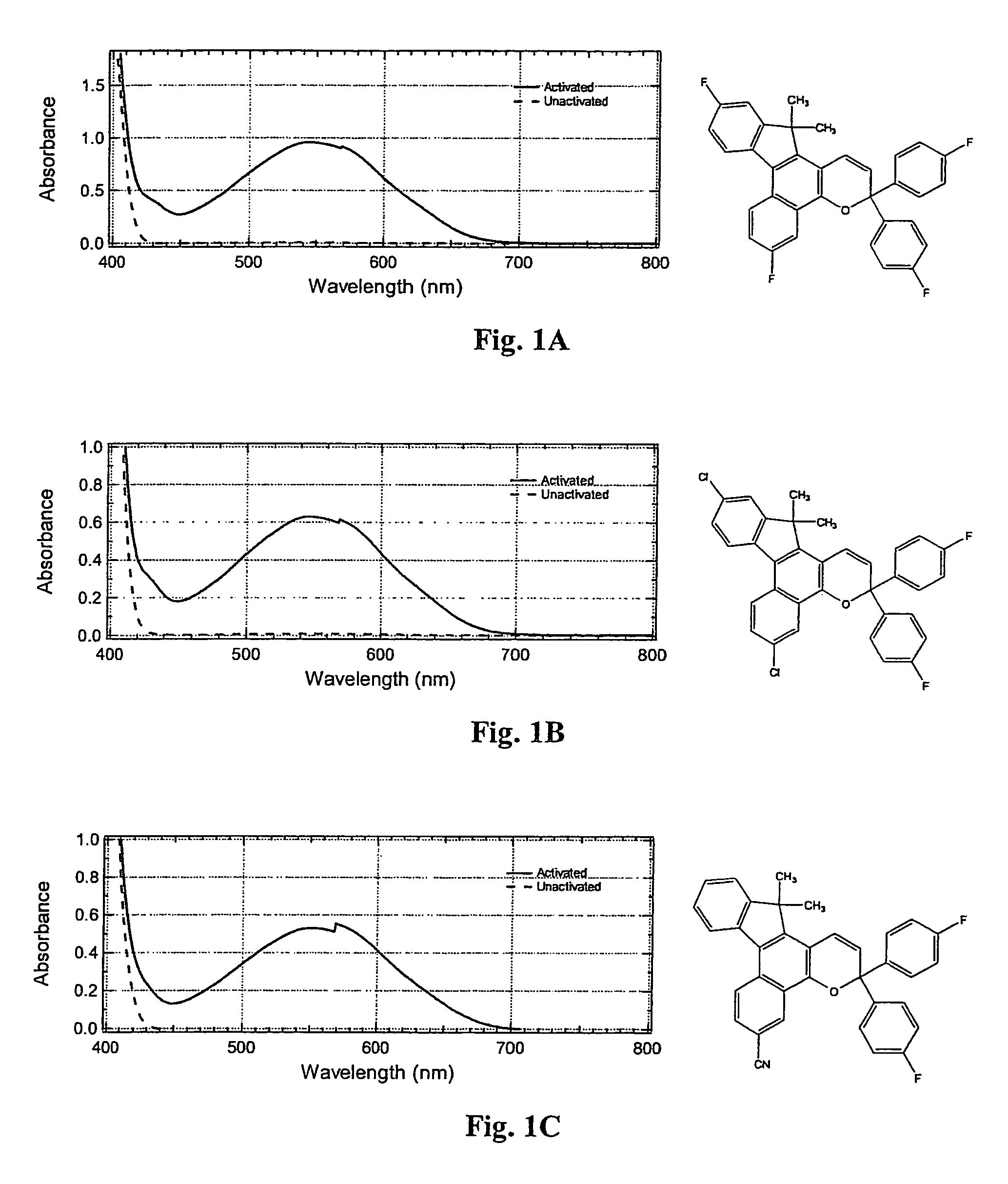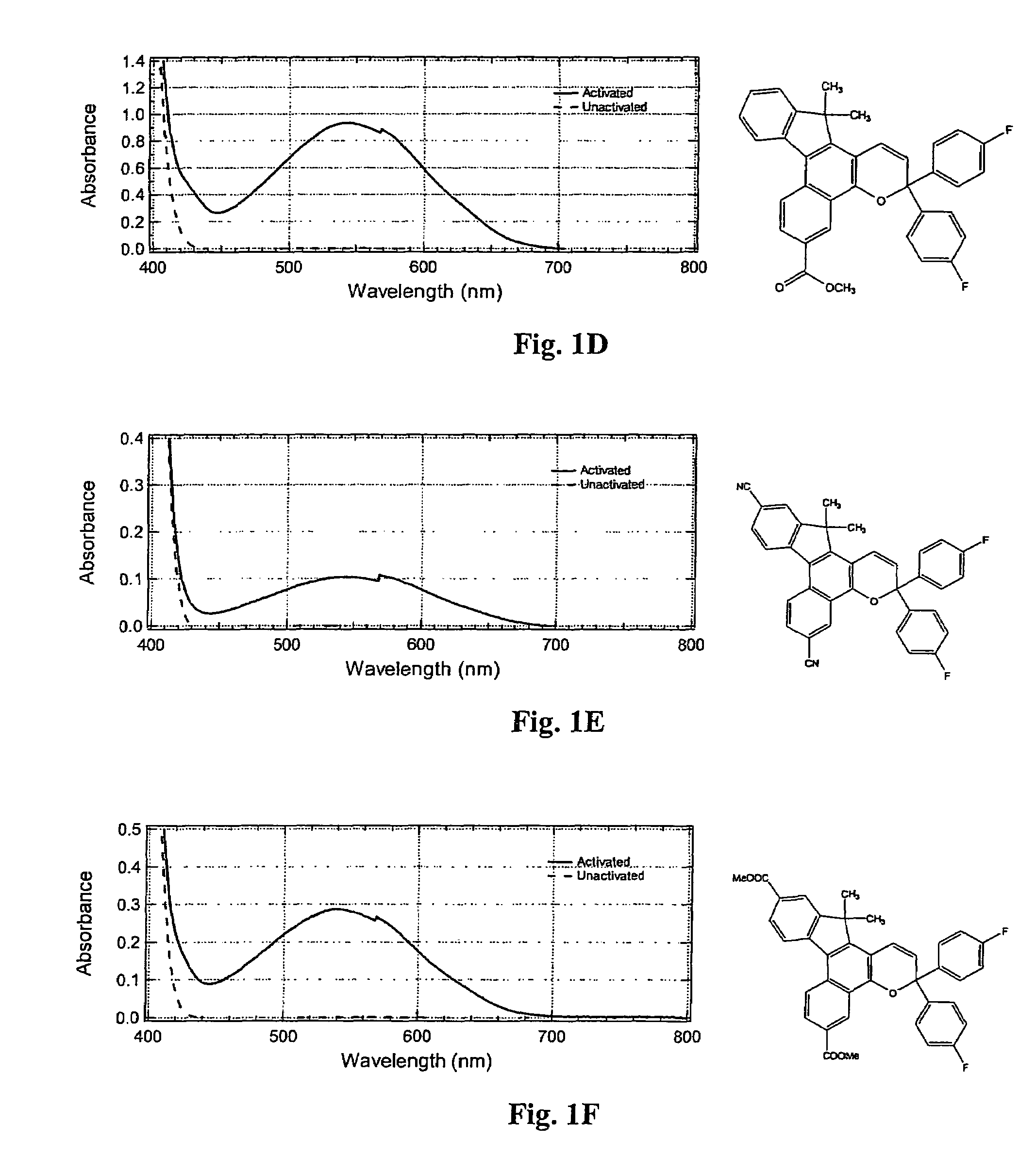Photochromic materials having electron-withdrawing substituents
a photochromic material and electron-withdrawing technology, applied in the field of photochromic materials, can solve the problems of inability to achieve inability to meet the needs of wearers, and inability to achieve the full color activated state of the lens when used in the automobile, etc., and achieve the effect of fast fade ra
- Summary
- Abstract
- Description
- Claims
- Application Information
AI Technical Summary
Benefits of technology
Problems solved by technology
Method used
Image
Examples
example 1
Step 1
[0148]Potassium t-butoxide (68.8 grams) was weighed into a reaction flask equipped with a mechanical stirrer, placed under a nitrogen atmosphere and 700 milliliters (mL) of toluene was added followed by 4,4′-difluorobenzophenone (100 grams). The reaction mixture was stirred mechanically and heated to 70° C. A solution of dimethyl succinate (80 grams) in 100 mL of toluene was added to the reaction mixture over a 60 minute period. The reaction mixture was heated at 70° C. for 4 hours. After cooling to room temperature, the reaction mixture was poured into 500 mL of water and the toluene layer discarded. The aqueous layer was extracted with diethyl ether (1×400 mL) to remove the neutral products, and then acidified the aqueous layer with concentrated HCl. A brownish-yellow oily solid was obtained from the aqueous layer, and was extracted with 3×300 mL of ethyl acetate. The organic layers were combined, washed with saturated NaCl solution (1×500 mL) and dried over anhydrous sodium...
example 2
Step 1
[0153]Anisole (27.5 grams), 4-fluorobenzoyl chloride (35 grams) and dichloromethane (250 mL) were combined in a reaction flask. Aluminum chloride (30.8 grams) was added to the reaction mixture slowly over 20 minutes. Stirred the reaction mixture at room temperature for two hours and then poured it into a mixture of 70 mL concentrated HCl and 500 mL of water. The layers were phase separated and the aqueous layer was extracted with 2 portions of dichloromethane (300 mL each). The organic portions were combined and washed with saturated aqueous sodium bicarbonate (400 mL). The organic layer was dried over anhydrous sodium sulfate and evaporated to yielding 48.0 grams of 4-fluoro-4′-methoxy-benzophenone as a white solid. This material was not purified further but was used directly in the next step.
Step 2
[0154]4-Fluoro-4′-methoxy-benzophenone from Step 1 (126.7 grams) and acetylene saturated N,N-dimethylformamide (380 mL) were combined in a reaction flask. Sodium acetylide solution...
example 3
[0156]The product of Example 1, Step 4 (3,9-difluoro-7,7-dimethyl-5-hydroxy-7H-benzo[C]fluorene, 5.7 grams), 1-phenyl-1-(4-morpholinophenyl)-2-propyn-1-ol (5.7 grams), 4 drops of dodecyl benzene sulfonic acid and 250 mL of chloroform were combined in a reaction flask and stirred at reflux temperatures under a nitrogen atmosphere. After one hour, an additional 0.5 grams of the 1-phenyl-1-(4-morpholinophenyl)-2-propyn-1-ol and 1 drop of dodecyl benzene sulfonic acid were added to the reaction mixture. The reaction mixture was heated at reflux for 2 hours more, and then cooled to room temperature. The reaction mixture was washed carefully with a mixture of 100 mL of a saturated sodium bicarbonate solution and 100 mL of water. The organic layer was separated, dried over sodium sulfate, and concentrated by rotary evaporation. The residue was chromatographed on a silica gel column using a mixture of hexane, methylene chloride and ethyl acetate (50 / 45 / 5) as the eluant. Photochromic fractio...
PUM
 Login to View More
Login to View More Abstract
Description
Claims
Application Information
 Login to View More
Login to View More - R&D
- Intellectual Property
- Life Sciences
- Materials
- Tech Scout
- Unparalleled Data Quality
- Higher Quality Content
- 60% Fewer Hallucinations
Browse by: Latest US Patents, China's latest patents, Technical Efficacy Thesaurus, Application Domain, Technology Topic, Popular Technical Reports.
© 2025 PatSnap. All rights reserved.Legal|Privacy policy|Modern Slavery Act Transparency Statement|Sitemap|About US| Contact US: help@patsnap.com



